For homeowners and businesses alike, ensuring that your HVAC system functions efficiently is crucial to comfort and energy savings. One of the most common questions asked is, which way does air filter go in HVAC? This seemingly simple question is vital for maintaining the cleanliness and efficiency of your HVAC system. In this article, we will explore the importance of proper air filter installation and the correct orientation of air filters in HVAC systems.

Understanding the HVAC System
To understand which way the air filter goes, it is important to have a basic understanding of how an HVAC system operates. HVAC systems are responsible for Heating, Ventilation, and Air Conditioning. They ensure indoor air quality and maintain thermal comfort.
Components of an HVAC System
- Furnace: Provides heating via combustion or electrical means.
- Air Conditioner: Cools and dehumidifies the air.
- Ductwork: Transports air to different parts of a building.
- Air Filters: Remove contaminants from the air before it’s heated or cooled.
The Role of Air Filters
The primary function of air filters is to trap dust, pollen, and other particles that could harm the HVAC system’s components or degrade indoor air quality. Proper installation is essential to ensure these contaminants are effectively captured.
Types of Air Filters
- Pleated Filters: Known for their high efficiency and durability.
- Fiberglass Filters: Economical and disposable, suitable for most basic systems.
- HEPA Filters: High-efficiency filters that capture 99.97% of particles.
Which Way Does the Air Filter Go?
The direction in which an air filter is installed can impact the system’s performance. Installing a filter backward will not filter air as effectively and can restrict airflow, putting extra strain on the HVAC system.
Step-by-Step Installation Guide
- Turn off the HVAC system to ensure safety.
- Locate the air filter compartment.
- Determine the airflow direction, usually marked by an arrow.
- Slide the new filter into place, ensuring the arrow points in the correct direction, aligning with the airflow towards the furnace or AC.
- Secure the cover and turn on the system.
For more detailed instructions, check out this guide.
Why Proper Installation Matters
The correct installation of the air filter in an HVAC system influences energy efficiency, indoor air quality, and the longevity of the HVAC components. Incorrect installation can lead to higher energy bills and an increased need for repairs.
Benefits of Correct Installation
- Improved air quality
- Reduced energy consumption
- Extended lifespan of the HVAC system
- Lower maintenance costs
Common Mistakes to Avoid
Avoiding common mistakes is key to ensuring your HVAC system runs smoothly. Here are some to watch out for:
- Not replacing the filter regularly
- Using the wrong filter for your system
- Ignoring the airflow directional arrows on the filter
Frequently Asked Questions
- What happens if I install the filter backward?
Installing the filter backward can restrict airflow, making the system work harder and less efficiently, leading to higher energy costs and potential damage.
- How often should I replace my HVAC filter?
It’s recommended to replace your filter every 1-3 months, depending on usage and filter type.
- Can I use a higher MERV rated filter than recommended?
Using a higher MERV filter than recommended can restrict airflow. Always check your HVAC system requirements before upgrading filters.

Conclusion
Understanding which way does air filter go in HVAC ensures efficient operation, lower energy costs, and improved indoor air quality. With proper installation and maintenance, homeowners can enjoy the full benefits of a well-maintained HVAC system.
For more information on related topics, consider visiting articles like dryer vent installation or air quality threats.






